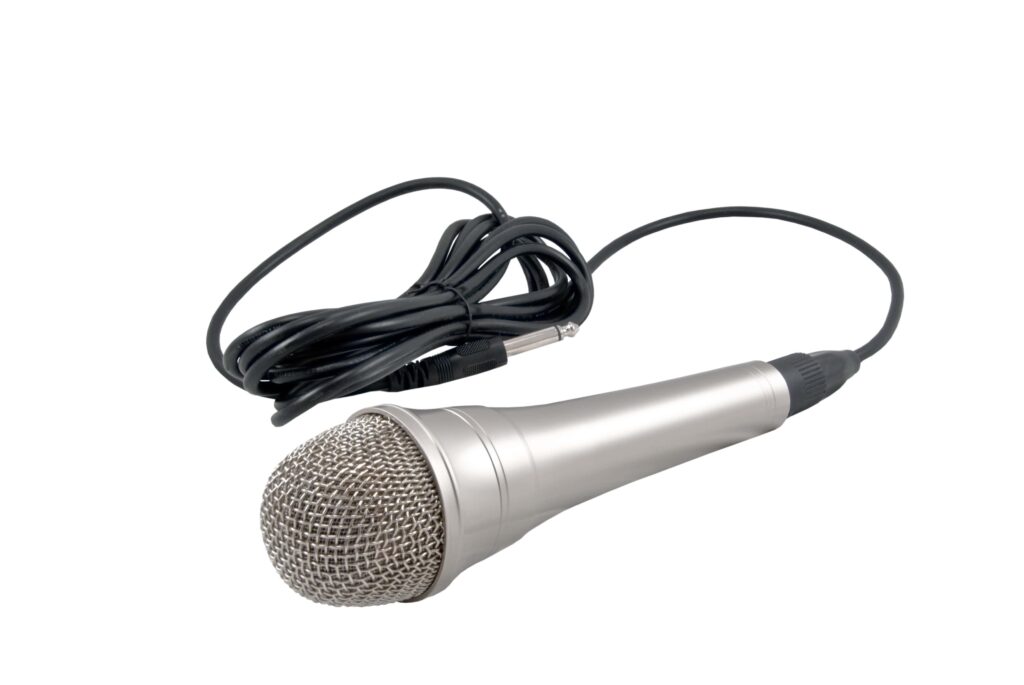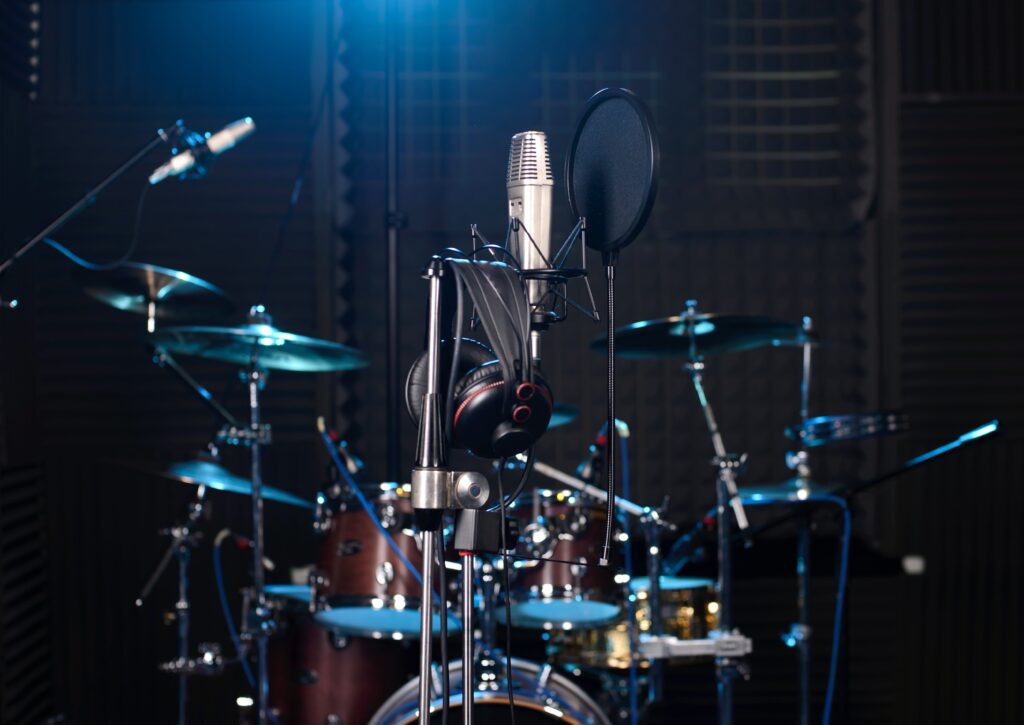The first handheld microphone, called a “dynamic microphone,” was made by a Norwegian company called Elektrofon in 1916. Later, the company changed its name to Aktiebolaget Electro-Voice or just Electro-Voice. The first handheld microphone was made for the military, but the entertainment industry quickly picked it up because the sound was so clear. Handheld microphones have changed in appearance, but the idea behind them has stayed the same.
What is the handheld microphone?
A handheld microphone is also known as a dynamic microphone. A handheld microphone is designed to be held in the hand of the user while in use. It is commonly used during live performances and when the microphone needs to be moved around freely. Singers and other performers, as well as speakers and other presenters, often use handheld microphones.
How many types of handheld microphone?
There are 2 major types of handheld microphones.
- Wired Handheld Microphone
- Wireless Handheld Microphone OR Bluetooth Microphone Handheld
Dynamic Handheld Microphones
Dynamic handheld mics are often used in audio applications because they are durable and can be used in many ways. The way these mics work is called electromagnetic induction. In a dynamic microphone, a diaphragm is connected to a coil of wire inside a magnet’s magnetic field. When waves of sound hit the diaphragm, it moves. This causes the ring to move within the magnetic field, creating an electrical current representing the audio information.
One of the best things about dynamic handheld mics is that they last a long time. They are made to handle rough handling and high sound pressure levels, which makes them perfect for live shows and recording instruments like guitar amplifiers and drums. Also, dynamic microphones don’t need an outside power source because the diaphragm’s movement creates the required electrical information. Because they are simple and don’t need much power, they are practical and easy to use in many situations.
But dynamic mics have their problems as well. Compared to condenser mics, they tend to have a narrower frequency response and less sensitivity, which means they might not pick up the slightest sounds. They may not be the best choice for recording details in a studio, where high sensitivity is essential. They are very durable and inexpensive, making them great for stage shows, public speaking, and picking up loud sounds.
Condenser Handheld Microphones
Handheld condenser microphones use a sophisticated and sensitive technology that makes them popular for studio recording, live shows, and capturing subtle sounds. The electrostatic concept is used in condenser microphones but not dynamic microphones. They have a diaphragm close to a backplate, which makes a capacitor (also called a condenser). When sound waves hit the diaphragm, the distance between the backplate and the diaphragm changes, which changes the capacitance; then, these differences are turned into an electrical signal, which makes an obvious and accurate copy of the sound.
One of the best things about handheld condenser mics is their sensitivity. These microphones can pick up a more comprehensive range of frequencies and respond quickly to changes in volume. This makes them great for picking up subtle sounds and details. Because of this, condenser microphones are best for recording vocals, acoustic instruments, and studio settings where clarity and precision are essential.
Also, condenser mics can pick up low and high frequencies with great accuracy because they have a comprehensive frequency response. Because of this, they are perfect for recording the full range of sound accurately. Compared to dynamic microphones, they also have a higher output level and less self-noise, which makes for a cleaner and more detailed sound input.
But there are also some bad things about these good things. Compared to dynamic microphones, condenser mics are less durable and more sensitive to loud sounds. They have to be powered by something else, like a battery or phantom power from a mixer or audio interface, which can be problematic in some setups.
Condenser handheld mics can be used for professional studio recordings, vocal performances, podcasts, ASMR recordings, and capturing acoustic instruments like pianos and violins. Condenser microphones are the best choice when capturing high-quality audio in a controlled setting. They are very sensitive and can reproduce sounds in great detail.
Polar Patterns (Cardioid, Omnidirectional, Supercardioid)
Cardioid: Captures sound from the front while minimizing noise from the sides and rear. Ideal for isolating a specific sound source.
Omnidirectional: Picks up sound from all directions, making it suitable for recording in a controlled environment where ambient noise needs to be captured.
Supercardioid: Similar to cardioid but with a narrower pickup angle, focusing more precisely on the sound source while rejecting some surrounding noise.
The body and hold
Materials and Ergonomics: The bases of microphones are usually made of metal or high-quality plastic to make them last longer and reduce reverberation. Ergonomic designs make it easy to use for a long time, which is essential for live shows and recording sessions.
On/Off Switches and Controls: Some handheld mics have on/off switches that make it easy to control how much sound comes in. These switches keep the microphone from making noise when it’s not used. This gives you options for different uses.
XLR Connections vs. USB Connections
Connections to XLR
Pros:
XLR connections provide a balanced output, reducing noise and ensuring high-quality audio is sent. They are common in professional audio setups and make connections that work well.
Cons:
The length of the wire is limited, and it’s usually used in stationary setups.
USB connections
Pros:
USB speakers are easy to connect to computers and portable devices because you plug them in and use them. They are suitable for home records, voiceovers, and podcasting.
Cons:
Cable length is limited and may not protect against noise and XLR connections. It’s not strong enough for professional studio use but it’s great for newbies and casual users.
Practical Tips for Using Handheld Microphones
Proper Holding and Handling Techniques
Holding a handheld microphone properly assures optimal sound quality and minimizes handling noise. Avoid covering the grille, which can impede sound, by grasping the microphone near its base. This could transmit bearing noise into the microphone. Maintaining a steady and audible tone requires a relaxed grasp.
Microphone Positioning and Distance
Maintain an appropriate distance between the microphone and the source of the sound. The optimal length for most handheld microphones is between 2 and 4 inches (5 to 10 centimeters) from the mouth. Experiment with different angles and distances to find the optimal position for capturing sound without distortion. Adjust the tip of the microphone to prevent the plosives sound (such as “p” and “b”) from striking the diaphragm directly and causing distortion.
Reducing Handling Noise
Handling noise, which is caused by touching or bumping the microphone, can be problematic. Use a shock mount or grasp the microphone’s base to reduce this. Purchase microphones with integrated shock mounts or use external shock mounts and microphone supports whenever possible. During a performance or recording session, you should also hold the microphone still and move slowly and deliberately if adjustments are required.
Maintenance and Cleaning Tips
Regular maintenance ensures the durability and peak performance of your handheld microphone.
Use a gentle, moist cloth to wipe down the microphone’s exterior. To prevent damage, avoid spraying cleaning agents directly onto the microphone. Use a brush to remove debris and moisture from the grille.
Store the microphone in a protective case or pouch to prevent grime and physical damage when not in use.
Keeping away from Avoid exposing the microphone to liquids and moisture. If the microphone becomes damp, remove the battery (if applicable) and allow it to air-dry before use.
Examine Cables
Examine the microphone cable frequently for symptoms of wear or damage. Replace damaged lines immediately to maintain signal transmission clarity.
By following to these guidelines, users can ensure the effectiveness and dependability of handheld microphones in various contexts, including on stage, in the studio, and during recordings.
What is a wired handheld microphone, and what are its pros and cons?
A wired handheld microphone is an older version dynamic microphone. A cable connects a handheld wired microphone to the sound system or recording device. A wired handheld microphone was used a lot in the past and is still used.
Here are several Pros and Cons of using wired handheld microphones
What is a wireless handheld microphone?
People often use a wireless handheld microphone for things like karaoke, public speaking, and recording sound for videos. Most of the time, they are small and portable, which makes them easy to take with you and use on the go.
what are its pros and cons?
You may buy a wireless handheld microphone for more than one reason. So here are some Pros of a wireless handheld microphone.
Conclusion:
Understanding the components and techniques associated with handheld microphones is crucial for obtaining the highest possible audio quality. Dynamic microphones, known for their resilience, are appropriate for high-pressure environments, whereas condenser microphones provide superior sensitivity and detail for nuanced recordings. Proper handling, correct positioning, and addressing handling disturbance are crucial for capturing clear sound. The user’s requirements determine the choice between XLR and USB connections, weighing convenience and audio quality.
Consider the intended use, budget, and environmental conditions when selecting a handheld microphone. Invest in quality accessories such as shock mounts and microphone supports to improve your equipment’s stability and sound quality. Maintenance and appropriate storage are essential for extending the microphone’s life. Additionally, always test the microphone and familiarize yourself with its characteristics before critical performances or recordings.
Lastly, embrace the realm of aural technology and continue to investigate. Experimenting with various types and brands of microphones can help you find the one that best suits your particular requirements. As technology advances, innovations continuously transform the audio recording landscape. Enhance your audio experiences and creations by retaining a sense of wonder, experimenting with various techniques, and keeping abreast of the latest portable microphone developments.
Best wishes with your recording!




